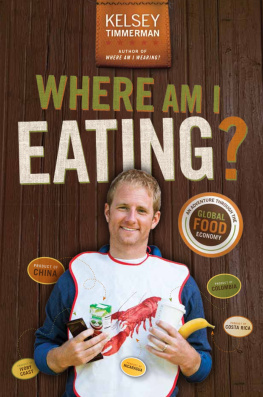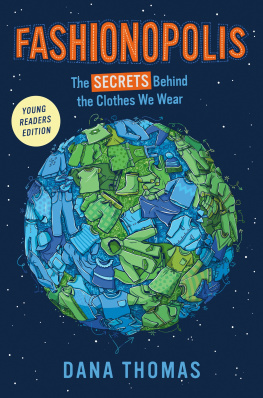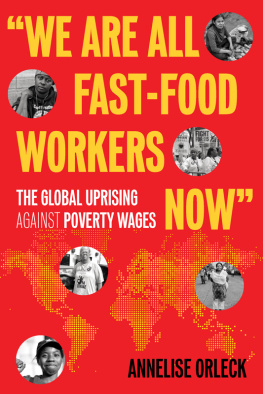Contents

Copyright 2012 by Kelsey Timmerman. All rights reserved.
Published by John Wiley & Sons, Inc., Hoboken, New Jersey.
Published simultaneously in Canada.
No part of this publication may be reproduced, stored in a retrieval system, or transmitted in any form or by any means, electronic, mechanical, photocopying, recording, scanning, or otherwise, except as permitted under Section 107 or 108 of the 1976 United States Copyright Act, without either the prior written permission of the Publisher, or authorization through payment of the appropriate per-copy fee to the Copyright Clearance Center, Inc., 222 Rosewood Drive, Danvers, MA 01923, (978) 750-8400, fax (978) 646-8600, or on the web at www.copyright.com . Requests to the Publisher for permission should be addressed to the Permissions Department, John Wiley & Sons, Inc., 111 River Street, Hoboken, NJ 07030, (201) 748-6011, fax (201) 748-6008, or online at http://www.wiley.com/go/permissions .
Limit of Liability/Disclaimer of Warranty: While the publisher and author have used their best efforts in preparing this book, they make no representations or warranties with respect to the accuracy or completeness of the contents of this book and specifically disclaim any implied warranties of merchantability or fitness for a particular purpose. No warranty may be created or extended by sales representatives or written sales materials. The advice and strategies contained herein may not be suitable for your situation. You should consult with a professional where appropriate. Neither the publisher nor author shall be liable for any loss of profit or any other commercial damages, including but not limited to special, incidental, consequential, or other damages.
For general information on our other products and services or for technical support, please contact our Customer Care Department within the United States at (800) 762-2974, outside the United States at (317) 572-3993 or fax (317) 572-4002.
Wiley publishes in a variety of print and electronic formats and by print-on-demand. Some material included with standard print versions of this book may not be included in e-books or in print-on-demand. If this book refers to media such as a CD or DVD that is not included in the version you purchased, you may download this material at http://booksupport.wiley.com . For more information about Wiley products, visit www.wiley.com .
Library of Congress Cataloging-in-Publication Data:
Timmerman, Kelsey, 1979
Where Am I Wearing?: A Global Tour to the Countries, Factories, and People That Make Our Clothes / Kelsey Timmerman. Rev. and updated.
p. cm.
ISBN: 978-1-118-27755-3 (pbk)
ISBN: 978-1-118-35608-1 (ebk)
ISBN: 978-1-118-35609-8 (ebk)
ISBN: 978-1-118-35610-4 (ebk)
1. Clothing trade. 2. Clothing workers. 3. WagesClothing workers. 4. ConsumersAttitudes. I. Title.
HD9940.A2T56 2012
338.47687dc23
2012003583
To all the people who make the clothes I wear.
And to Annie,
who makes sure all the clothes I wear match.
We are all caught in an inescapable network of mutuality, tied into a single garment of destiny. Whatever affects one directly, affects all indirectly.
Martin Luther King Jr.
Preface
Below me is the Caribbean. Behind me is a global adventure that changed my life and the way I live it. Ahead of me is Honduras, where all of this began six years ago.
The world has changed since I last visited Honduras and stood in front of the factory where my T-shirt was made.
The first edition of this book came out in November of 2008. You likely remember this as a time where any investments you held suddenly halved. Jobs were lost. Home values continued to plummet. In other words, it was a great time to have a book come out.
The world is coming to an end, a crazed-hair friend may have warned. Better stock up on guns and gold! Oh, by the way, have you heard about this book called Where Am I Wearing? This fella named Kelsey went to Bangladesh because his underwear were made there! Its only $25, which is about how much your stock portfolio lost in the last five minutes.
Bullet sales in the United States went up 49 percent while book sales dropped 9 percent, but the down economy had a much wider impact than the publishing industry and the lives of first-time authors. The global financial crisis impacted every single person I met on my global quest to meet the people who made my clothes. Food prices skyrocketed. Arifa, the single mother of three in Bangladesh, was now forced to spend over half of her income on rice for her family. Sixty-four million people fell into extreme povertyliving on less than $1.25 per day. Eighty-two million more people were going hungry.
Orders for just about everything declined, and global unemployment increased by 34 million. The blue jean factory at which Nari and Aitwo of the workers I met in Cambodiaworked closed. There were reports of workersprimarily women in their late teens and early 20sturning to prostitution. Were Nari and Ai and the others I met in Cambodia among them?
My wardrobe has changed, but not as much as I have.
Since I last sat on a plane nosing toward San Pedro Sula, Honduras, I got married and had two kids. I see the world through a dads eyes now. Eyes that water when I watch Toy Story 3 with my daughter, Harper. Eyes that look toward a future beyond my own. Eyes that better see where I fit in as a local citizen in my hometown of Muncie, Indiana, and where I fit in as a global citizen. This second edition of Where Am I Wearing? is essentially about the sacrifices parents and children make for one another in the hopes of a better life. Until I looked upon my own children, I only saw the world through the invincible eyes of a son. Having kids changed me, but so did the mothers and fathers, sisters and brothers I met tracking down who made my clothes and where.
The other day I was on a stage at one of the universities that selected this book for their freshman common reader program. All incoming freshmen read and discussed the bookan amazing experience to have as an author. This particular university dressed me in regaliaHarry Potter robes with shoulder pads sans magic wand. I tried to convince the university that if they make an author wear regalia they should give him an honorary degree, but they wouldnt bite. (I would have questioned their integrity if they had.) I felt silly. Then I clicked to the first slide of my presentationa 20-foot-tall picture of Arifa in Bangladeshand completely forgot about the pomp and circumstance.
When I met Arifa in Bangladesh, I had no idea I would be able to share her story in the way that I have. There was no promise of a book. But there I stood before 1,500 students and faculty, and they all knew her name. They all knew her story. Ive stood on other stages at universities and high schools across the country, and it never gets old. It is an absolute honor to share her story and all of the others.
When my editor, Richard, called me about updating this book, I was in the middle of brushing my daughters teeth. He asked me if I had any ideas for new material. Boy, did I.
Ive always felt that this book was missing something. The whole experience began in Honduras where I followed my favorite T-shirts tag. At first it was an excuse to travel. I went jungle hiking, SCUBA diving, and taught an entire island village to play baseball. But when I showed up at the factory and met a worker named Amilcar, I completely chickened out. I didnt ask the questions I wanted to know about him: Does this job provide a better life for you and your family? What do you get paid? What are the working conditions like? And so on. I think deep down I really didnt want to know about the realities of Amilcars life, so I didnt ask.












